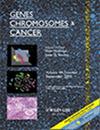Macroscopic Monozygotic Androgenetic/Biparental Mosaicism: Molecular Characterization and Clinical Implications
Abstract
Hydatidiform moles represent abnormal pregnancies characterized by trophoblastic hyperproliferation. However, accurate diagnosis of partial hydatidiform moles (PHM) remains challenging. We present a rare case of a monozygotic androgenetic/biparental mosaic in a 26-year-old primigravida. The patient was referred to our institution for a suspected PHM, and ultrasonography revealed a nonviable embryo-like structure alongside villous formations with focal cystic changes. Pathological examination of the evacuated tissue revealed the coexistence of normal and hydropic villi. Histological assessment with p57KIP2 immunohistochemistry initially suggested PHM; however, some cytotrophoblasts and villous stromal cells were negative for p57KIP2 immunoreactivity. Therefore, we conducted short tandem repeat analysis separately for normal villous tissue and cystic villous lesions to elucidate the genetic origin of this unusual presentation. The normal villous portion exhibited biparental diploidy, whereas the cystic villous portion exhibited androgenetic monospermic patterns. Comparisons across all 16 loci revealed concordance between the paternal alleles of biparental diploid villi and the androgenic molar alleles, indicating a single sperm origin. SNP array analysis with B allele frequency plotting confirmed these findings at the whole-genome level; normal villi showed biparental diploid patterns, whereas cystic villi displayed uniparental disomic patterns. These results demonstrate that both components originated from a monozygotic conception rather than from dizygotic twinning. Therefore, we propose a clinical category based on the sequelae of endoduplication and the formation of a tripolar spindle apparatus through the first meiotic division, encompassing macroscopic androgenetic/biparental mosaicism, twin pregnancy with a hydatidiform mole, microscopic androgenetic/biparental mosaicism, and confined placental mosaicism. Given the presence of androgenetic elements and our institutional experience with gestational trophoblastic neoplasia development in a similar case, we recommend that such cases be managed according to complete hydatidiform mole surveillance protocols. This case highlights the diagnostic challenges posed by monozygotic androgenetic/biparental mosaic mechanisms and emphasizes the importance of molecular genetic analysis for the accurate diagnosis and appropriate clinical management of atypical hydatidiform moles.

 求助内容:
求助内容: 应助结果提醒方式:
应助结果提醒方式:


